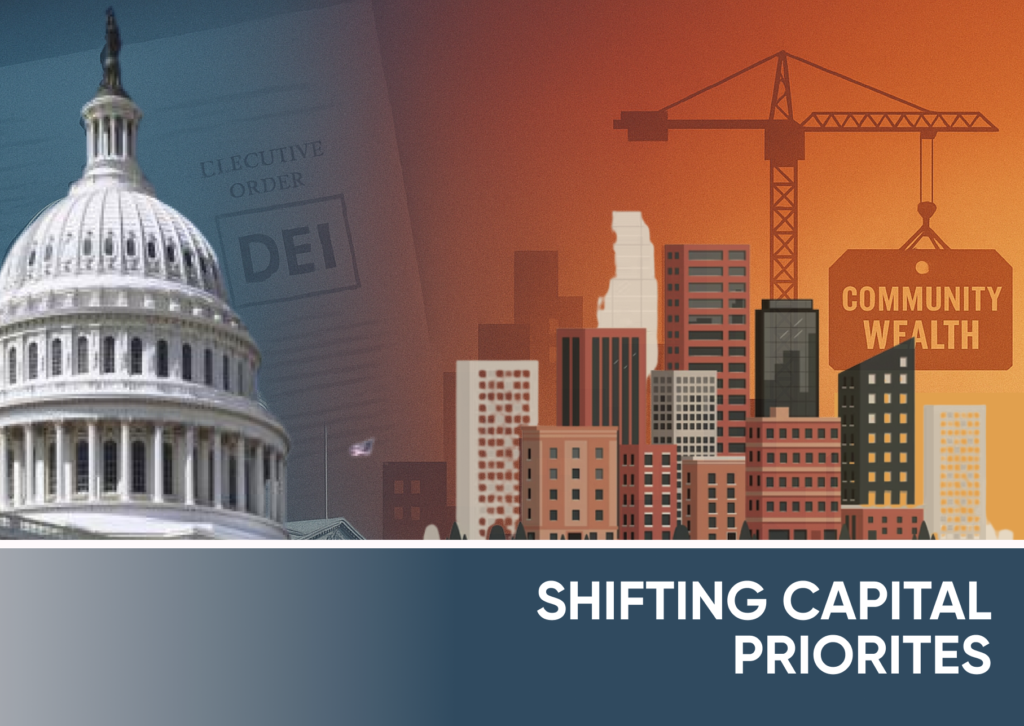Since President Trump’s return to office, a chilling effect has swept across philanthropic, financial, and impact investment communities. Executive Orders aimed at dismantling DEI-related infrastructure—such as the directive to eliminate the non-statutory functions of the CDFI Fund—have triggered a domino effect. What began as legal posturing has quickly evolved into a sweeping reevaluation of funding priorities, commitments, and public messaging across the capital landscape.
While many in the public sector await the legal outcomes of these orders, private sector actors are already shifting course. And for small, diverse, and emerging real estate operators this shift carries both threat and opportunity. The question now is not if the capital landscape is changing, but how to strategically respond.
How Funders Are Shifting
1. Public Filings Go Silent on Race: Financial institutions like BlackRock and TPG have scrubbed references to race-specific goals in their public ESG reports. Language once highlighting “racial equity” has been replaced with broader terms like “underserved communities.” While the intent may still exist internally, this change signals a de-risking strategy in public positioning.
2. Redefining DEI Initiatives: Goldman Sachs recently removed race-specific language from its “One Million Black Women” initiative, expanding its scope to include all solo entrepreneurs. This is part of a broader trend of shifting from targeted programs to more generalized economic mobility initiatives.
3. Investor Withdrawals from Diversity Funds: Diversity-focused funds have experienced significant outflows—$1.2 billion in 2023 and another $376 million in 2024. Fund managers who had previously leaned into DEI narratives are now finding their limited partners less eager to continue down that path.
3. Philanthropic Retrenchment: Even progressive institutions are pulling back. The Chan Zuckerberg Initiative recently scaled down its internal DEI teams and halted funding for social justice efforts. The Ford Foundation and others have begun rebranding their portfolios to focus on “economic justice” or “inclusive entrepreneurship,” often broadening definitions in ways that dilute focus on race and identity.
4. CDFIs Caught in the Crossfire: Executive Orders aimed at eliminating non-statutory functions of the CDFI Fund have introduced uncertainty. While the Treasury Department has since affirmed that all 11 of the Fund’s programs are legally authorized, the damage to perceived stability is done. Some CDFIs are now focusing on geographic or economic hardship criteria rather than race or ethnicity to protect their eligibility for future federal and private funding.
How Small, Diverse, and Emerging Firms Can Respond
This evolving capital landscape may be disheartening, but it’s also revealing where the seams of opportunity lie. Here’s how entrepreneurs can pivot:
1. Follow the Language, Not Just the Money
Instead of looking for programs explicitly labeled as “DEI,” track emerging terms such as:
1. Inclusive Capital
2. Community Wealth Building
3. Equitable Development
4. Place-Based Investment These rebranded efforts are still targeting historically disadvantaged groups but in a more politically neutral way.
2. Reframe the Pitch
When fundraising, lead with your investment thesis—not your identity. Make the case for:
1. Market inefficiencies you are exploiting
2. Underserved geographic zones with high ROI potential
3. How your firm’s lived experience is an informational advantage—not just a moral one
3. Forge Partnerships with Generalist Impact Funds
Many mainstream impact investors are still hungry for deals that check multiple boxes—climate, housing, infrastructure, and community uplift. Position yourself as a partner who can deliver against these priorities while bringing authentic ties to communities they want to serve.
4. Tap into Corporate ESG Funds Still in Play
Despite broader retrenchment, many Fortune 500 companies are still deploying capital through supplier diversity initiatives and local reinvestment programs. Engage directly with their ESG, procurement, or real estate departments to uncover nontraditional capital partnerships.
5. CDFI Engagement Still Matters—but Play the Long Game
CDFIs remain vital sources of subordinate debt and technical assistance, especially in real estate. But given political uncertainty, be prepared to:
1. Provide more rigorous documentation of “community benefit”
2. Compete in broader applicant pools
3. Partner with anchor institutions (like hospitals or universities) to reduce perceived risk
Finding the Opportunity in the Unraveling
While the political climate is forcing a retreat from explicit racial equity commitments, new lanes are opening for operators who can:
1. Speak the evolving language of capital allocators
2. Offer deal structures that de-risk investment
3. Align with thematic priorities like climate resilience, affordable housing, and economic mobility
Most important, this moment calls for collaboration among Black and Brown operators, developers, fund managers, and advisors. We may no longer be able to rely on the promise of top-down reform—but we can build networks, capital pools, and institutional strength from within. Adaptation, not appeasement, is the key. Let’s shift from waiting for access to building leverage.



